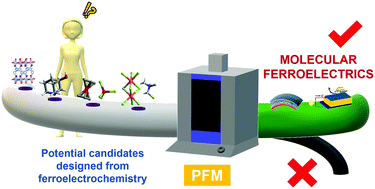PFM (piezoresponse force microscopy)-aided design for molecular ferroelectrics†
Abstract
With prosperity, decay, and another spring, molecular ferroelectrics have passed a hundred years since Valasek first discovered ferroelectricity in the molecular compound Rochelle salt. Recently, the proposal of ferroelectrochemistry has injected new vigor into this century-old research field. It should be highlighted that piezoresponse force microscopy (PFM) technique, as a non-destructive imaging and manipulation method for ferroelectric domains at the nanoscale, can significantly speed up the design rate of molecular ferroelectrics as well as enhance the ferroelectric and piezoelectric performances relying on domain engineering. Herein, we provide a brief review of the contribution of the PFM technique toward assisting the design and performance optimization of molecular ferroelectrics. Relying on the relationship between ferroelectric domains and crystallography, together with other physical characteristics such as domain switching and piezoelectricity, we believe that the PFM technique can be effectively applied to assist the design of high-performance molecular ferroelectrics equipped with multifunctionality, and thereby facilitate their practical utilization in optics, electronics, magnetics, thermotics, and mechanics among others.



 Please wait while we load your content...
Please wait while we load your content...